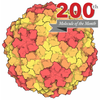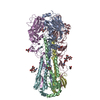[English] 日本語
 Yorodumi
Yorodumi- PDB-9b2m: Hemagglutinin H1 New Caledonia 1999 in complex with monoclonal an... -
+ Open data
Open data
- Basic information
Basic information
| Entry | Database: PDB / ID: 9b2m | |||||||||
|---|---|---|---|---|---|---|---|---|---|---|
| Title | Hemagglutinin H1 New Caledonia 1999 in complex with monoclonal antibody Fab 43_S0008 | |||||||||
 Components Components |
| |||||||||
 Keywords Keywords | VIRAL PROTEIN/IMMUNE SYSTEM / influenza virus / broadly neutralizing antibody / bnAb / VH1-69 / DH3-9 / hemagglutinin / HA / stem / stalk / germline-targeting / VIRAL PROTEIN / VIRAL PROTEIN-IMMUNE SYSTEM complex | |||||||||
| Function / homology |  Function and homology information Function and homology informationviral budding from plasma membrane / clathrin-dependent endocytosis of virus by host cell / host cell surface receptor binding / fusion of virus membrane with host plasma membrane / fusion of virus membrane with host endosome membrane / viral envelope / virion attachment to host cell / host cell plasma membrane / virion membrane / membrane Similarity search - Function | |||||||||
| Biological species |   Influenza A virus Influenza A virus | |||||||||
| Method | ELECTRON MICROSCOPY / single particle reconstruction / cryo EM / Resolution: 3.09 Å | |||||||||
 Authors Authors | Torrents de la Pena, A. / de Paiva Froes Rocha, R. / Ward, A.B. / Ataca, S. / Kanekiyo, M. | |||||||||
| Funding support |  United States, 2items United States, 2items
| |||||||||
 Citation Citation |  Journal: Cell Rep / Year: 2024 Journal: Cell Rep / Year: 2024Title: Modulating the immunodominance hierarchy of immunoglobulin germline-encoded structural motifs targeting the influenza hemagglutinin stem. Authors: Sila Ataca / Maya Sangesland / Rebeca de Paiva Fróes Rocha / Alba Torrents de la Peña / Larance Ronsard / Seyhan Boyoglu-Barnum / Rebecca A Gillespie / Yaroslav Tsybovsky / Tyler Stephens ...Authors: Sila Ataca / Maya Sangesland / Rebeca de Paiva Fróes Rocha / Alba Torrents de la Peña / Larance Ronsard / Seyhan Boyoglu-Barnum / Rebecca A Gillespie / Yaroslav Tsybovsky / Tyler Stephens / Syed M Moin / Julia Lederhofer / Adrian Creanga / Sarah F Andrews / Ralston M Barnes / Daniel Rohrer / Nils Lonberg / Barney S Graham / Andrew B Ward / Daniel Lingwood / Masaru Kanekiyo /  Abstract: Antibodies targeting epitopes through germline-encoded motifs can be found in different individuals. While these public antibodies are often beneficial, they also pose hurdles for subdominant ...Antibodies targeting epitopes through germline-encoded motifs can be found in different individuals. While these public antibodies are often beneficial, they also pose hurdles for subdominant antibodies to emerge. Here, we use transgenic mice that reproduce the human IGHV1-6901 germline-encoded antibody response to the conserved stem epitope on group 1 hemagglutinin (HA) of influenza A virus to show that this germline-endowed response can be overridden by a subdominant yet cross-group reactive public antibody response. Immunization with a non-cognate group 2 HA stem enriched B cells harboring the IGHD3-9 gene, thereby switching from IGHV1-69- to IGHD3-9-encoded motif-dependent epitope recognition. These IGHD3-9 antibodies bound, neutralized, and conferred cross-group protection in mice against influenza A viruses. A cryoelectron microscopy (cryo-EM) structure of an IGHD3-9 antibody resembled the human broadly neutralizing antibody FI6v3, which uses IGHD3-9. Together, our findings offer insights into vaccine regimens that engage an immunoglobulin repertoire with broader cross-reactivity to influenza A viruses. | |||||||||
| History |
|
- Structure visualization
Structure visualization
| Structure viewer | Molecule:  Molmil Molmil Jmol/JSmol Jmol/JSmol |
|---|
- Downloads & links
Downloads & links
- Download
Download
| PDBx/mmCIF format |  9b2m.cif.gz 9b2m.cif.gz | 454.3 KB | Display |  PDBx/mmCIF format PDBx/mmCIF format |
|---|---|---|---|---|
| PDB format |  pdb9b2m.ent.gz pdb9b2m.ent.gz | 358 KB | Display |  PDB format PDB format |
| PDBx/mmJSON format |  9b2m.json.gz 9b2m.json.gz | Tree view |  PDBx/mmJSON format PDBx/mmJSON format | |
| Others |  Other downloads Other downloads |
-Validation report
| Summary document |  9b2m_validation.pdf.gz 9b2m_validation.pdf.gz | 1.8 MB | Display |  wwPDB validaton report wwPDB validaton report |
|---|---|---|---|---|
| Full document |  9b2m_full_validation.pdf.gz 9b2m_full_validation.pdf.gz | 1.8 MB | Display | |
| Data in XML |  9b2m_validation.xml.gz 9b2m_validation.xml.gz | 74.4 KB | Display | |
| Data in CIF |  9b2m_validation.cif.gz 9b2m_validation.cif.gz | 110.5 KB | Display | |
| Arichive directory |  https://data.pdbj.org/pub/pdb/validation_reports/b2/9b2m https://data.pdbj.org/pub/pdb/validation_reports/b2/9b2m ftp://data.pdbj.org/pub/pdb/validation_reports/b2/9b2m ftp://data.pdbj.org/pub/pdb/validation_reports/b2/9b2m | HTTPS FTP |
-Related structure data
| Related structure data |  44112MC M: map data used to model this data C: citing same article ( |
|---|---|
| Similar structure data | Similarity search - Function & homology  F&H Search F&H Search |
- Links
Links
- Assembly
Assembly
| Deposited unit | 
|
|---|---|
| 1 |
|
- Components
Components
| #1: Protein | Mass: 37803.648 Da / Num. of mol.: 3 Source method: isolated from a genetically manipulated source Details: Hemagglutinin New Caledonia 1999 HA1 / Source: (gene. exp.)   Influenza A virus / Gene: HA / Production host: Influenza A virus / Gene: HA / Production host:  Homo sapiens (human) / References: UniProt: Q6WG00 Homo sapiens (human) / References: UniProt: Q6WG00#2: Protein | Mass: 25550.836 Da / Num. of mol.: 3 Source method: isolated from a genetically manipulated source Details: Hemagglutinin H1 New Caledonia 1999 / Source: (gene. exp.)   Influenza A virus / Gene: HA / Production host: Influenza A virus / Gene: HA / Production host:  Homo sapiens (human) / References: UniProt: Q6WG00 Homo sapiens (human) / References: UniProt: Q6WG00#3: Antibody | Mass: 24914.199 Da / Num. of mol.: 3 Source method: isolated from a genetically manipulated source Source: (gene. exp.)   Homo sapiens (human) Homo sapiens (human)#4: Antibody | Mass: 24034.838 Da / Num. of mol.: 3 Source method: isolated from a genetically manipulated source Source: (gene. exp.)   Homo sapiens (human) Homo sapiens (human)#5: Sugar | ChemComp-NAG / Has ligand of interest | Y | Has protein modification | Y | |
|---|
-Experimental details
-Experiment
| Experiment | Method: ELECTRON MICROSCOPY |
|---|---|
| EM experiment | Aggregation state: PARTICLE / 3D reconstruction method: single particle reconstruction |
- Sample preparation
Sample preparation
| Component | Name: Hemagglutinin H1 New Caledonia 1999 in complex with monoclonal antibody Fab 43_S0008 Type: COMPLEX Details: Fab fragment was generated using papain digestion and size exclusion chromatography. The complex was incubated overnight and the sample was purified using size exclusion chromatography Entity ID: #2-#4 / Source: RECOMBINANT |
|---|---|
| Molecular weight | Value: 0.330 MDa / Experimental value: YES |
| Source (natural) | Organism:  Homo sapiens (human) Homo sapiens (human) |
| Source (recombinant) | Organism:  Homo sapiens (human) Homo sapiens (human) |
| Buffer solution | pH: 7.4 / Details: TBS |
| Specimen | Conc.: 2 mg/ml / Embedding applied: NO / Shadowing applied: NO / Staining applied: NO / Vitrification applied: YES |
| Specimen support | Grid material: COPPER / Grid mesh size: 300 divisions/in. / Grid type: Quantifoil R1.2/1.3 |
| Vitrification | Instrument: FEI VITROBOT MARK IV / Cryogen name: ETHANE / Humidity: 100 % / Chamber temperature: 40 K |
- Electron microscopy imaging
Electron microscopy imaging
| Experimental equipment |  Model: Titan Krios / Image courtesy: FEI Company |
|---|---|
| Microscopy | Model: FEI TITAN KRIOS |
| Electron gun | Electron source:  FIELD EMISSION GUN / Accelerating voltage: 300 kV / Illumination mode: FLOOD BEAM FIELD EMISSION GUN / Accelerating voltage: 300 kV / Illumination mode: FLOOD BEAM |
| Electron lens | Mode: BRIGHT FIELD / Nominal defocus max: 1500 nm / Nominal defocus min: 800 nm / Cs: 2.7 mm / C2 aperture diameter: 100 µm |
| Image recording | Electron dose: 50 e/Å2 / Detector mode: COUNTING / Film or detector model: GATAN K2 SUMMIT (4k x 4k) |
- Processing
Processing
| EM software |
| ||||||||||||||||||||||||||||||||||||||||
|---|---|---|---|---|---|---|---|---|---|---|---|---|---|---|---|---|---|---|---|---|---|---|---|---|---|---|---|---|---|---|---|---|---|---|---|---|---|---|---|---|---|
| CTF correction | Type: PHASE FLIPPING AND AMPLITUDE CORRECTION | ||||||||||||||||||||||||||||||||||||||||
| Symmetry | Point symmetry: C3 (3 fold cyclic) | ||||||||||||||||||||||||||||||||||||||||
| 3D reconstruction | Resolution: 3.09 Å / Resolution method: FSC 0.143 CUT-OFF / Num. of particles: 190711 / Symmetry type: POINT | ||||||||||||||||||||||||||||||||||||||||
| Atomic model building | PDB-ID: 4m4y Accession code: 4m4y / Source name: PDB / Type: experimental model |
 Movie
Movie Controller
Controller


 PDBj
PDBj










